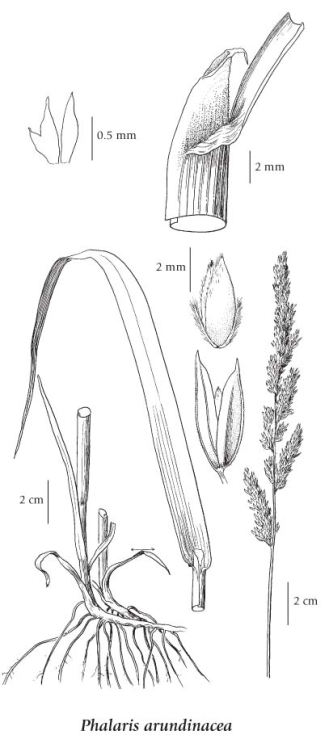reed canarygrass
Poaceae (Grass family)
Introduction to Vascular Plants
SUBTAXA PRESENT IN BC
Introduction
Reed canary grass is a cool season perennial grass species with noticeable creeping rhizomes. It is a sod-forming species. Reed canary grass is listed as native in North America by the USDA, where it is found across the continent in most states and provinces (USDA 2010). However, cultivars brought in for ornamental use and as pasture grasses have been introduced from Europe and Asia. These hybridize with native populations, producing aggressive offspring in the central and western regions of the continent (Invasive.org 2009). This mixture of native and introduced types has resulted in debate about the invasiveness and origins of the species in some regions. This species is tolerant of freezing and emerges early in the spring, giving it a competitive advantage (Global Invasive Species Database 2010). It favours wet, poorly drained sites and may be found in ditches, along the edges of ponds and lakes, in marshlands, and in wet meadows. The earliest collection of this species in the UBC Herbarium is by Agnes L. Hill, 1897, from Port Hardy.
|
Species Information
General:
Perennial grass from conspicuous rhizomes; stems 50-150 (200) cm tall.
Leaves:
Sheaths open; blades flat, 7-17 mm wide; ligules rounded, usually with irregular, jagged margins, turned backwards, short-hairy externally, 4-10 mm long.
Flowers:
Inflorescence a compact panicle, 7-15 (25) cm long, the branches more or less spreading at maturity; glumes slightly unequal, minutely rough and short-hairy, 3-nerved, sharp-pointed, 4.5-5 mm long; sterile lemmas hairy, brownish, 1-1.5 mm long; fertile lemmas nearly smooth, lightly 5-nerved, 3-4 mm long; paleas 2-nerved, nearly equal to the lemmas; lodicules lanceolate, about 0.5 mm long; anthers 2.5-3 mm long.
Notes:
Sometimes introduced as a pasture grass. The variegated ornamental form (forma variegata [Parnell] Druce [var. picta L.]) sometimes occurs as a garden escape.
Illustration

If more than one illustration is available for a species (e.g., separate illustrations were provided for two subspecies) then links to the separate images will be provided below. Note that individual subspecies or varietal illustrations are not always available.
Illustration Source: The Illustrated Flora of British Columbia
USDA Species Characteristics
Flower Colour:
Yellow
Blooming Period:
Late Spring
Fruit/Seed characteristics:
Colour: Black
Present from Spring to Summer
Source: The USDA
Ecology
The table below shows the species-specific information calculated from
original data (BEC database) provided by the BC Ministry of Forests and Range.
(Updated August, 2013)
| Site Information |
Value / Class |
||
|
Avg |
Min |
Max |
|
| Elevation
(metres) |
597 | 5 | 1642 |
| Slope
Gradient (%) |
1 | 0 | 50 |
|
Aspect (degrees) |
55 | 12 | 360 |
| Soil
Moisture Regime (SMR) [0 - very xeric; 4 - mesic; 8 - hydric] |
5 | 0 | 8 |
| Modal
Nutrient Regime
Class |
D | ||
| #
of field plots species was recorded in: |
116 | ||
| Modal
BEC Zone Class |
IDF | ||
|
All BEC Zones (# of stations/zone) species was recorded in |
BG(14), CDF(10), CWH(16), ESSF(1), ICH(11), IDF(36), MS(2), PP(6), SBPS(2), SBS(15) | ||
|
Source:
Klinkenberg 2013
|
|||
Habitat and Range
Wet meadows, ditches and lakeshores in the lowland and steppe to subalpine zones; common in S BC, rare northward; circumpolar N to AK, YT and NT, E to NF and S to ME, MA, PA, VA, AL, AR, OK, NM, AZ and CA; Eurasia.Synonyms
Synonyms and Alternate Names:
Phalaris arundinacea var. picta L.
Phalaroides arundinacea (L.) Raeusch.
Phalaroides arundinacea var. picta (L.) Tzvelev
Taxonomic Notes
Cultivars of this species are still sold in nurseries in British Columbia, including Phalaris arundinacea 'Feesey' - Ribbon Grass. Seeds are sold online.
|
References
Invasive.org. 2009. Invasive Plant Atlas of the United States. US National Park Service, the University of Georgia Center for Invasive Species and Ecosystem Health, and the Invasive Plant Atlas of New England. Available Online.
USDA 2010. Plant profile for Phalaris arundinacea. United States Department of Agriculture. Available Online.